2025年高一英语初升高衔接复习 句子成分 课件2(共53张PPT)
文档属性
| 名称 | 2025年高一英语初升高衔接复习 句子成分 课件2(共53张PPT) |  | |
| 格式 | pptx | ||
| 文件大小 | 28.2MB | ||
| 资源类型 | 教案 | ||
| 版本资源 | 通用版 | ||
| 科目 | 英语 | ||
| 更新时间 | 2025-08-04 11:22:26 | ||
图片预览

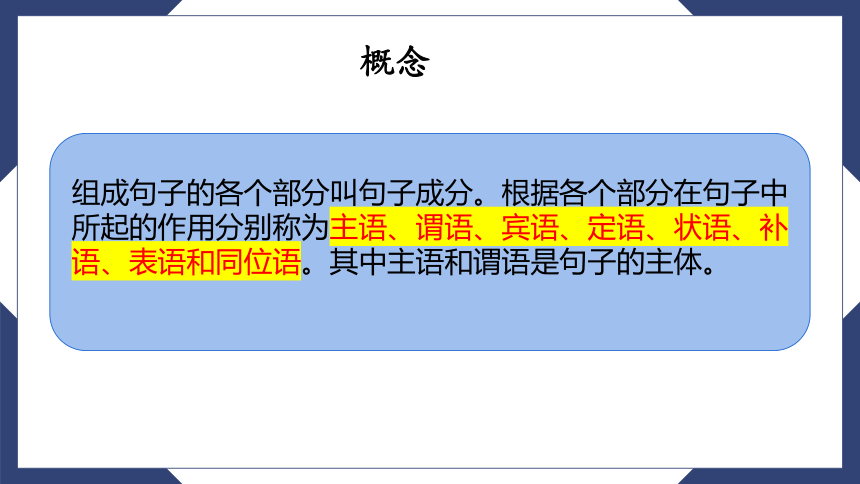

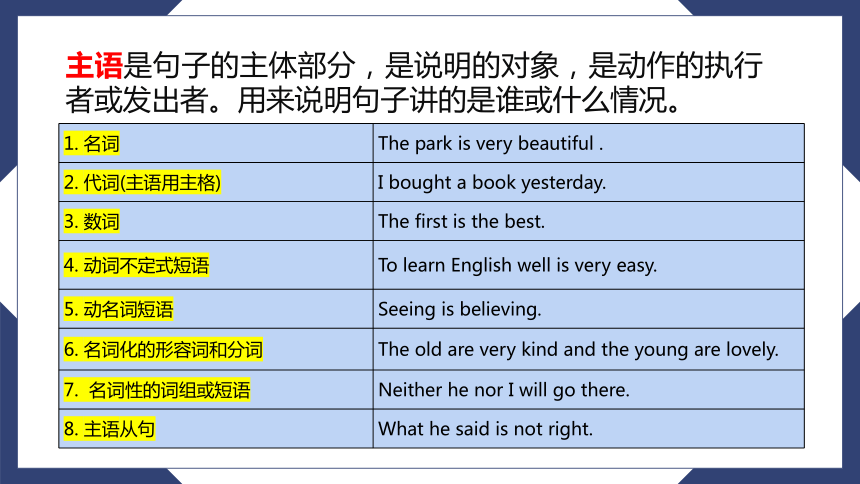
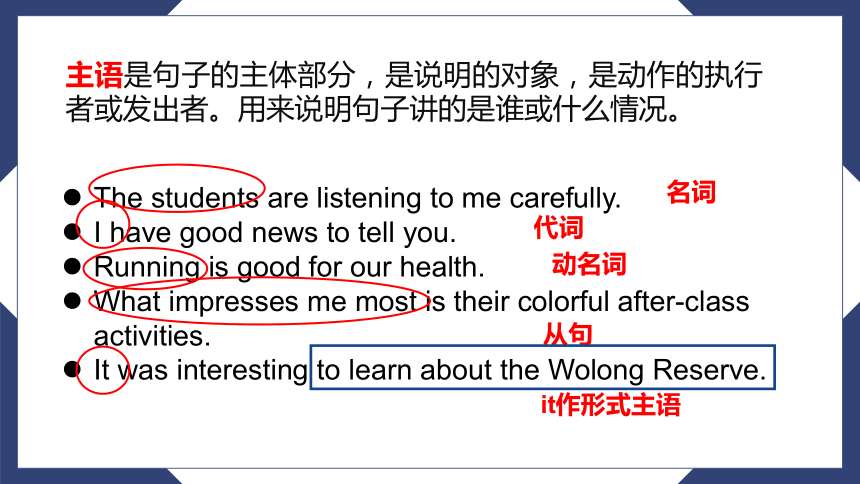
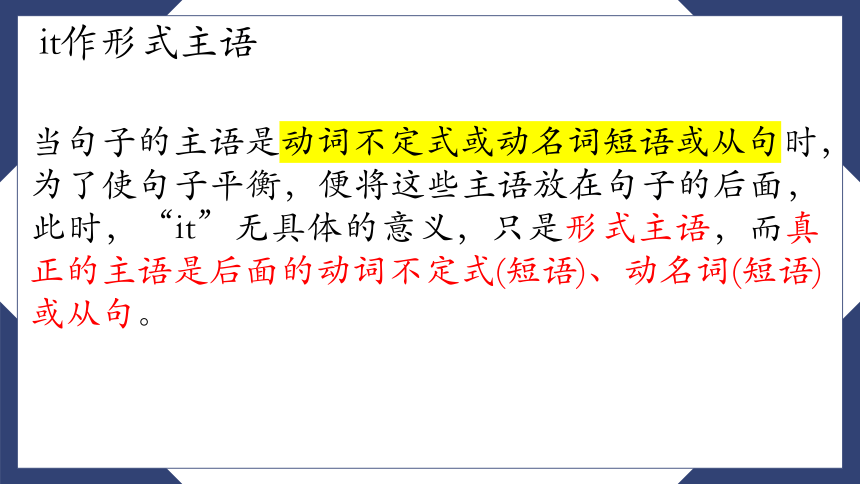

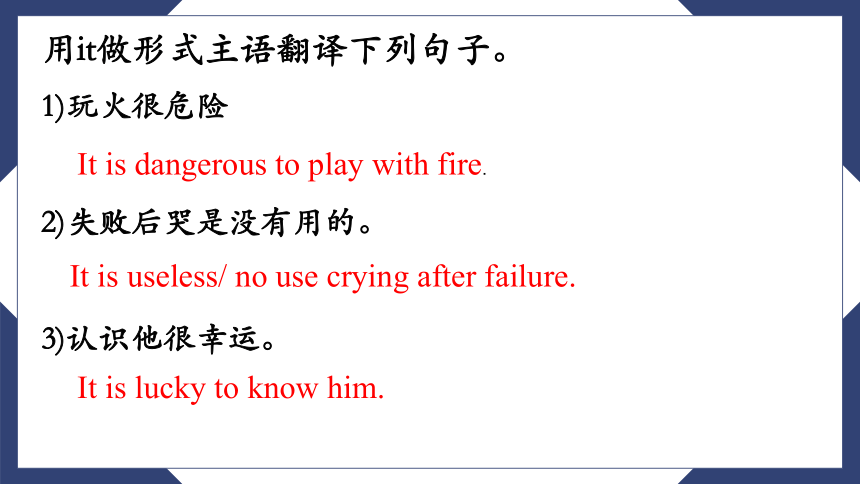
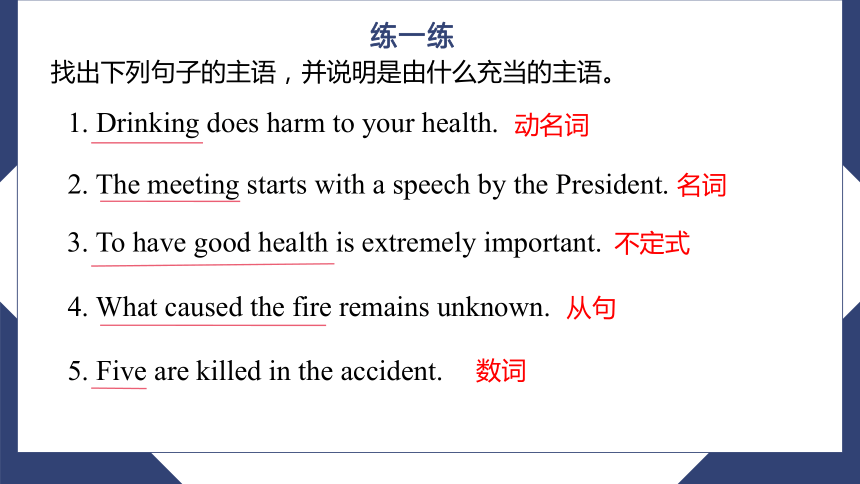



文档简介
(共53张PPT)
英语的句子成分
概念
组成句子的各个部分叫句子成分。根据各个部分在句子中所起的作用分别称为主语、谓语、宾语、定语、状语、补语、表语和同位语。其中主语和谓语是句子的主体。
主语(Subject)
01
主语是句子的主体部分,是说明的对象,是动作的执行者或发出者。用来说明句子讲的是谁或什么情况。
1. 名词 The park is very beautiful .
2. 代词(主语用主格) I bought a book yesterday.
3. 数词 The first is the best.
4. 动词不定式短语 To learn English well is very easy.
5. 动名词短语 Seeing is believing.
6. 名词化的形容词和分词 The old are very kind and the young are lovely.
7. 名词性的词组或短语 Neither he nor I will go there.
8. 主语从句 What he said is not right.
主语是句子的主体部分,是说明的对象,是动作的执行者或发出者。用来说明句子讲的是谁或什么情况。
The students are listening to me carefully.
I have good news to tell you.
Running is good for our health.
What impresses me most is their colorful after-class activities.
It was interesting to learn about the Wolong Reserve.
名词
代词
动名词
从句
it作形式主语
it作形式主语
当句子的主语是动词不定式或动名词短语或从句时,为了使句子平衡,便将这些主语放在句子的后面,此时,“it”无具体的意义,只是形式主语,而真正的主语是后面的动词不定式(短语)、动名词(短语)或从句。
it作形式主语
1)动词不定式短语
It is easy to learn English well.
2)动名词短语(主要用于以no good, no use, useless, worthwhile, a waste of time等词做表语的句子中)
It is useless/ no use crying over split milk.
Is it worthwhile working so hard
It is no good having a car if you can't drive.
用it做形式主语翻译下列句子。
1)玩火很危险
2)失败后哭是没有用的。
3)认识他很幸运。
It is dangerous to play with fire.
It is useless/ no use crying after failure.
It is lucky to know him.
练一练
1. Drinking does harm to your health.
找出下列句子的主语,并说明是由什么充当的主语。
2. The meeting starts with a speech by the President.
3. To have good health is extremely important.
4. What caused the fire remains unknown.
5. Five are killed in the accident.
动名词
名词
不定式
从句
数词
谓语(Predicate)
02
概念
谓语用来说明主语的状态或行为动作。谓语主要由动词或动词短语充当。谓语有时态、语态、主谓一致的变化。谓语有简单谓语和复合谓语之分
谓语动词具有时态和语态的变化。
找出下列句子的错误并改正
I buy a book in a shop yesterday.
His novel translated into English.
bought
was translated
16种时态 现在 过去 将来 过去将来
一般动作 do/does did shall/will do should/would do
进行动作 be+doing was/were doing shall/will be doing should/would be doing
完成动作 has/have done had done shall/will have done should/would have done
完成进行动作 has/have been doing had been doing shall/will have been doing should/would have been doing
谓语动词具有主谓一致的变化:
谓语动词在人称和数上和主语保持一致。
他喜欢读书。
他们也喜欢读书。
He likes reading.
They also like reading.
(1)简单谓语:由一个实义动词或动词短语构成。
He runs every morning.他每天早上跑步。
(2)复合谓语:
①由情态动词/be动词/其他助动词+动词原形或动词的其他形式构成。
You may keep the book for two weeks.这本书你可借两周。
The students are playing basketball.学生们在打篮球。
②由系动词加表语构成。
We are students.我们是学生。
My head aches.
我头疼。
The students are studying in the classroom.
学生们正在教室里学习。
They have left.
他们已经走了。
系动词
1. 表“状态”:
2. 表“持续”:
3. 表“像”:
4. 表“感觉”:
5. 表“变化”:
6. 表“终止”:
remain, keep, stand
seem, appear, look
feel, smell, taste, look, sound
become, turn, make, grow, fall, get, go, come, run
prove, turn out(结果是...)
be动词
练一练
找出下列句子的谓语并指出谓语的构成。
1. His parents are teachers.
2. The old man died the next day.
3. We have finished reading this book.
4. You ought to work harder.
5. She felt very cold at that time.
6. He doesn’t like folk music.
系动词+表语
实义动词
助动词+过去分词
情态动词+动词原形
系动词+表语
助动词+动词原形
1.①He ②has_become more and more interested in English.
2.①The_living ②should_go_on_with his work.
3.①The_child ②has_been_brought_up by his grandmother.
4.①To_see ②is_to_believe.
5.①It ②is_necessary ③to_help_him_out.
6.①Four_plus_Five ②is_nine.
7.①He ②can_swim very well.
8.①Playing_football in the street ②is_dangerous.
1.He has become more and more interested in English.
2.The child has been brought up by his grandmother.
3.It is necessary to help him out.
4.He can swim very well.
5.Playing football in the street is dangerous.
指出下列句子中的主语和谓语
英语句子只能有一个主谓结构
若出现更多动词,则:
加连词(and / but / so…)
放入从句中,做从句谓语
变为非谓语动词
什么是非谓语动词呢?
“非”谓语即就是“不是”谓语,把不能、不必做谓语的动词,用另一种形式表现。
三种形式
分词
(过去/现在分词)
动名词
动词不定式
doing/done
doing
to do
宾语(Object)
03
概念
宾语表示动作的对象或承受者,由名词、代词、不定式或相当于名词的词、短语或从句来充当,它和谓语动词一起说明主语是什么,一般位于及物动词(短语)和介词之后。
Four people applied for this job, but we only need one.
1)名词 He lost his parents when he was young.
2)代词(宾语用宾格) I missed him very much.
3)数词 Four people applied for this job, but we only need one.
4)动词不定式短语 I like to read novels when I am free.
5)动名词短语 I haven't finished reading the book yet.
6)名词化的形容词和分词 The government's plan will hurt the poor and the unemployed.
7)名词性的词组或短语 I don't know the girl with a red hat.
8)宾语从句 I knew what you said.
哪些可以做宾语:
宾语种类:
特殊情况
1. 双宾语
有些及物动词后要求有两个宾语,直接宾语通常指物,表示动作的承受者;间接宾语通常指人,表示动作是对谁做的或是为谁做的;
Mother told me a story yesterday.
Please show me your passport(护照).
宾语种类:
特殊情况
有时,为了强调间接宾语,也可以将间接宾语后置,但这种情况下,间接宾语前必须加上介词to或for等。“to”更侧重于指出动作的直接接收者,而“for”则侧重于表达动作的目的或为某人做某事。
Lend me your book, please.
My father bought a gift for me.
My father bought me a gift.
Lend your book to me, please.
练一练
1.I want to visit the museum.
2.I enjoy listening to popular music.
3.I think that he is fit for the job.
4.I find it hard to learn English.
5.We should help the poor.
6.I don’t know where to go.
找出句中的宾语并写出类型。
名词
现在分词
宾语从句
不定式
the +adj
宾语从句
定语(Attribute)
04
概念
定语起修饰、限制名词或代词的作用,可分为前置定语和后置定语。单个词作定语时常放在被修饰词之前(前置定语),而短语或从句作定语时,往往放在被修饰词之后(后置定语)。
名词或名词所有格 They are talking about the world problems.
This is Tom's book.
代词 (形容词性物主代词) We should try our best to study hard to go to university.
数词 There are over 1000 people in the hall.
形容词 He is a strange man.
分词(短语) Do you know the number of the guest coming to the party
The story told by my mother is very interesting.
哪些词可以充当定语:表示...的
哪些词可以充当定语:
不定式 Can you tell me the way to solve the problem
介词短语 Did you find the key to the door
副词 Did you see the man upstairs/downstairs
定语从句 This is the school that l graduated from three years ago.
v
v
例句感知
1.The black bike is mine.
2.What’s your name
3.They made some paper flowers.
4.The boys in the room are in Class Three。
5.I have a lot of homework to do.
6.The tall boy who is standing there is Peter.
7.There are fallen leaves on the ground.
不定式
从句
过去分词
形容词
代词
名词
介词短语
练一练
1. She likes pink coats best.
2. There are hundreds of teenagers.
3. The dog running after the cat belongs to Miss Li.
4. This is the school that I want to go.
5. The boy crying over there is my sister.
6. The man who visited our class yesterday is warm-hearted.
找出句中的定语。
状语(Adverbial)
05
概念
状语用于修饰动词、形容词、副词或整个句子,说明动作或状态特征。可表示时间、地点、原因、目的、结果、方式、伴随、条件、程度、让步、频率等。状语的位置很灵活:一般放在句末,但有时也可以放在句首或句中。
类别:
1)副词/副词短语 The boy needs a pen [very much].(程度状语)
2)介词短语 [In the classroom], the boy needs a pen.(地点状语)
3)分词/分词短语 He sits there, [asking for a pen].(表示伴随状态)
4)不定式 The boy needs a pen [to do his homework].(目的状语)
5)名词 Come [this way]!/走这条路!(方向状语)
6)形容词(短语) At last he got home, tired and hungry.(方式状语)
7)从句(时间/地点/原因/结果/目的/比较/让步/条件状语从句) [If it rains tomorrow], we'll stay at home.(条件状语从句)
He did not go to school yesterday, [because he was ill].(原因状语从句)
练一练
1.I will be back in a minute.
2.They are playing on the playground.
3.He was late because he got up late.
4.I got up so late that I missed the train.
5.He often went to school by bike.
6. Please call me if it is necessary.
7.He went to school in spite of bad weather.
8.To make his dream come true, Tom works harder.
找出句中的状语,并说明其充当的是什么状语。
时间状语
地点状语
原因状语
结果状语
方式状语
条件状语
让步状语
目的状语
宾语补足语(Object Complement)
06
概念
宾语补足语对宾语进行补充说明。带有宾语补足语的一般句型为:某些及物动词(如make等)+宾语+宾补。宾语+宾补=复合宾语。
宾语+名词
We elected him chairman.
宾语+形容词
We found her face red.
They painted their boat white.
宾语+介词短语
The enemy found themselves in the valley.
宾补类型
宾语+不定式
I saw him cross the road.
注意,在一部分动词的后面,若用动词不定式作宾语补足语,则须省略去不定式符号to。这类动词是:“五看,三使役,二听,一感,半帮助” 但当这些动词转为被动语态时,原不带to的不定式要变成带to的不定式。
例:
He was seen to cross the road.
宾语+分词 ( v-ing / v-ed )
I saw him crossing the road.
(正在进行、主动的动作,用现在分词)
I saw him beaten in the street.
(被动、完成的动作,用过去分词)
练一练
1.We can’t leave him alone.
2.I regard him as my best friend.
3.The farmer asked us to have dinner.
4.I saw her playing on the playground.
5.She spoke loudly to make herself heard.
找出句中的宾语补足语,并说明是由什么充当的。
形容词
介词短语
不定式
现在分词
过去分词
Let the fresh air in.让新鲜空气进来。
You mustn't force him to lend his money to you.
你绝不可强迫他借钱给你。
We saw her entering the room.我们看见她进入了房间。
We found everything in the lab in good order.
我们发现实验室里的东西都井然有序。
表语(Predicative)
07
概念
表语用以说明主语的身份、特征、状态、性质、职业、数量、处所等,它一般位于系动词(如be, become, get, look, grow, turn, seem等)之后。表语一般由名词、代词、形容词、分词、数词、不定式、动名词、介词短语、副词及从句充当
表语用以说明主语的身份、特征、状态、性质、职业、数量、处所等,它一般位于系动词(如be, become, get, look, grow, turn, seem等)之后。表语一般由名词、代词、形容词、分词、数词、不定式、动名词、介词短语、副词及从句充当。
1.You look younger than before.
2.My father is a teacher.
3.My job is to teach them English.
4.That is why he didn’t come to school yesterday.
练一练
改正下列句子中的错误。
1. His job is train swimmers.
2. He seems interesting in the plans.
3. The cake smells nicely.
is后加to
interested
nice
1.He is a lovely boy.
2. Our monitor is always the first to enter the classroom.
3.He is playing happily.
4.I shall go there if it doesn't rain.
5.The story happened in Beijing.
指出下列句子中划线部分的句子成分。
定语
定语 定语
状语
状语
状语
6.He was so tired that he fell asleep immediately.
7.His coming late made his teacher unhappy.
8.Please keep the dog out.
9.When he woke up, he found himself under the bed.
10. She looks unhappy today.
状语
宾补
宾补
宾补
表语
11. He remained in poor health all those years.
12. I like listening to popular music.
13. They visited an exhibition yesterday.
14. My job is to teach English.
表语
宾语
表语
宾语
同位语(Appositive)
08
同位语是在名词或代词之后并列名词或代词,对句子中的名词(短语)或代词作进一步解释、说明,与前面的成分在语法上处于同等地位。英语句子表达中一般是没有同位语的,如果要对前面的名词的具体内容作进一步的说明,这时候就需要同位语。可以用作同位语的有:名词、代词、数词、介词短语、不定式、动名词和从句等。
1.We young people should respect the old.(名词)
2.He himself will do the experiment.(代词)
3.He is the oldest among them five. (数词)
4.News came that our team won the game. (从句)
感 谢 观 看
T H A N K S
英语的句子成分
概念
组成句子的各个部分叫句子成分。根据各个部分在句子中所起的作用分别称为主语、谓语、宾语、定语、状语、补语、表语和同位语。其中主语和谓语是句子的主体。
主语(Subject)
01
主语是句子的主体部分,是说明的对象,是动作的执行者或发出者。用来说明句子讲的是谁或什么情况。
1. 名词 The park is very beautiful .
2. 代词(主语用主格) I bought a book yesterday.
3. 数词 The first is the best.
4. 动词不定式短语 To learn English well is very easy.
5. 动名词短语 Seeing is believing.
6. 名词化的形容词和分词 The old are very kind and the young are lovely.
7. 名词性的词组或短语 Neither he nor I will go there.
8. 主语从句 What he said is not right.
主语是句子的主体部分,是说明的对象,是动作的执行者或发出者。用来说明句子讲的是谁或什么情况。
The students are listening to me carefully.
I have good news to tell you.
Running is good for our health.
What impresses me most is their colorful after-class activities.
It was interesting to learn about the Wolong Reserve.
名词
代词
动名词
从句
it作形式主语
it作形式主语
当句子的主语是动词不定式或动名词短语或从句时,为了使句子平衡,便将这些主语放在句子的后面,此时,“it”无具体的意义,只是形式主语,而真正的主语是后面的动词不定式(短语)、动名词(短语)或从句。
it作形式主语
1)动词不定式短语
It is easy to learn English well.
2)动名词短语(主要用于以no good, no use, useless, worthwhile, a waste of time等词做表语的句子中)
It is useless/ no use crying over split milk.
Is it worthwhile working so hard
It is no good having a car if you can't drive.
用it做形式主语翻译下列句子。
1)玩火很危险
2)失败后哭是没有用的。
3)认识他很幸运。
It is dangerous to play with fire.
It is useless/ no use crying after failure.
It is lucky to know him.
练一练
1. Drinking does harm to your health.
找出下列句子的主语,并说明是由什么充当的主语。
2. The meeting starts with a speech by the President.
3. To have good health is extremely important.
4. What caused the fire remains unknown.
5. Five are killed in the accident.
动名词
名词
不定式
从句
数词
谓语(Predicate)
02
概念
谓语用来说明主语的状态或行为动作。谓语主要由动词或动词短语充当。谓语有时态、语态、主谓一致的变化。谓语有简单谓语和复合谓语之分
谓语动词具有时态和语态的变化。
找出下列句子的错误并改正
I buy a book in a shop yesterday.
His novel translated into English.
bought
was translated
16种时态 现在 过去 将来 过去将来
一般动作 do/does did shall/will do should/would do
进行动作 be+doing was/were doing shall/will be doing should/would be doing
完成动作 has/have done had done shall/will have done should/would have done
完成进行动作 has/have been doing had been doing shall/will have been doing should/would have been doing
谓语动词具有主谓一致的变化:
谓语动词在人称和数上和主语保持一致。
他喜欢读书。
他们也喜欢读书。
He likes reading.
They also like reading.
(1)简单谓语:由一个实义动词或动词短语构成。
He runs every morning.他每天早上跑步。
(2)复合谓语:
①由情态动词/be动词/其他助动词+动词原形或动词的其他形式构成。
You may keep the book for two weeks.这本书你可借两周。
The students are playing basketball.学生们在打篮球。
②由系动词加表语构成。
We are students.我们是学生。
My head aches.
我头疼。
The students are studying in the classroom.
学生们正在教室里学习。
They have left.
他们已经走了。
系动词
1. 表“状态”:
2. 表“持续”:
3. 表“像”:
4. 表“感觉”:
5. 表“变化”:
6. 表“终止”:
remain, keep, stand
seem, appear, look
feel, smell, taste, look, sound
become, turn, make, grow, fall, get, go, come, run
prove, turn out(结果是...)
be动词
练一练
找出下列句子的谓语并指出谓语的构成。
1. His parents are teachers.
2. The old man died the next day.
3. We have finished reading this book.
4. You ought to work harder.
5. She felt very cold at that time.
6. He doesn’t like folk music.
系动词+表语
实义动词
助动词+过去分词
情态动词+动词原形
系动词+表语
助动词+动词原形
1.①He ②has_become more and more interested in English.
2.①The_living ②should_go_on_with his work.
3.①The_child ②has_been_brought_up by his grandmother.
4.①To_see ②is_to_believe.
5.①It ②is_necessary ③to_help_him_out.
6.①Four_plus_Five ②is_nine.
7.①He ②can_swim very well.
8.①Playing_football in the street ②is_dangerous.
1.He has become more and more interested in English.
2.The child has been brought up by his grandmother.
3.It is necessary to help him out.
4.He can swim very well.
5.Playing football in the street is dangerous.
指出下列句子中的主语和谓语
英语句子只能有一个主谓结构
若出现更多动词,则:
加连词(and / but / so…)
放入从句中,做从句谓语
变为非谓语动词
什么是非谓语动词呢?
“非”谓语即就是“不是”谓语,把不能、不必做谓语的动词,用另一种形式表现。
三种形式
分词
(过去/现在分词)
动名词
动词不定式
doing/done
doing
to do
宾语(Object)
03
概念
宾语表示动作的对象或承受者,由名词、代词、不定式或相当于名词的词、短语或从句来充当,它和谓语动词一起说明主语是什么,一般位于及物动词(短语)和介词之后。
Four people applied for this job, but we only need one.
1)名词 He lost his parents when he was young.
2)代词(宾语用宾格) I missed him very much.
3)数词 Four people applied for this job, but we only need one.
4)动词不定式短语 I like to read novels when I am free.
5)动名词短语 I haven't finished reading the book yet.
6)名词化的形容词和分词 The government's plan will hurt the poor and the unemployed.
7)名词性的词组或短语 I don't know the girl with a red hat.
8)宾语从句 I knew what you said.
哪些可以做宾语:
宾语种类:
特殊情况
1. 双宾语
有些及物动词后要求有两个宾语,直接宾语通常指物,表示动作的承受者;间接宾语通常指人,表示动作是对谁做的或是为谁做的;
Mother told me a story yesterday.
Please show me your passport(护照).
宾语种类:
特殊情况
有时,为了强调间接宾语,也可以将间接宾语后置,但这种情况下,间接宾语前必须加上介词to或for等。“to”更侧重于指出动作的直接接收者,而“for”则侧重于表达动作的目的或为某人做某事。
Lend me your book, please.
My father bought a gift for me.
My father bought me a gift.
Lend your book to me, please.
练一练
1.I want to visit the museum.
2.I enjoy listening to popular music.
3.I think that he is fit for the job.
4.I find it hard to learn English.
5.We should help the poor.
6.I don’t know where to go.
找出句中的宾语并写出类型。
名词
现在分词
宾语从句
不定式
the +adj
宾语从句
定语(Attribute)
04
概念
定语起修饰、限制名词或代词的作用,可分为前置定语和后置定语。单个词作定语时常放在被修饰词之前(前置定语),而短语或从句作定语时,往往放在被修饰词之后(后置定语)。
名词或名词所有格 They are talking about the world problems.
This is Tom's book.
代词 (形容词性物主代词) We should try our best to study hard to go to university.
数词 There are over 1000 people in the hall.
形容词 He is a strange man.
分词(短语) Do you know the number of the guest coming to the party
The story told by my mother is very interesting.
哪些词可以充当定语:表示...的
哪些词可以充当定语:
不定式 Can you tell me the way to solve the problem
介词短语 Did you find the key to the door
副词 Did you see the man upstairs/downstairs
定语从句 This is the school that l graduated from three years ago.
v
v
例句感知
1.The black bike is mine.
2.What’s your name
3.They made some paper flowers.
4.The boys in the room are in Class Three。
5.I have a lot of homework to do.
6.The tall boy who is standing there is Peter.
7.There are fallen leaves on the ground.
不定式
从句
过去分词
形容词
代词
名词
介词短语
练一练
1. She likes pink coats best.
2. There are hundreds of teenagers.
3. The dog running after the cat belongs to Miss Li.
4. This is the school that I want to go.
5. The boy crying over there is my sister.
6. The man who visited our class yesterday is warm-hearted.
找出句中的定语。
状语(Adverbial)
05
概念
状语用于修饰动词、形容词、副词或整个句子,说明动作或状态特征。可表示时间、地点、原因、目的、结果、方式、伴随、条件、程度、让步、频率等。状语的位置很灵活:一般放在句末,但有时也可以放在句首或句中。
类别:
1)副词/副词短语 The boy needs a pen [very much].(程度状语)
2)介词短语 [In the classroom], the boy needs a pen.(地点状语)
3)分词/分词短语 He sits there, [asking for a pen].(表示伴随状态)
4)不定式 The boy needs a pen [to do his homework].(目的状语)
5)名词 Come [this way]!/走这条路!(方向状语)
6)形容词(短语) At last he got home, tired and hungry.(方式状语)
7)从句(时间/地点/原因/结果/目的/比较/让步/条件状语从句) [If it rains tomorrow], we'll stay at home.(条件状语从句)
He did not go to school yesterday, [because he was ill].(原因状语从句)
练一练
1.I will be back in a minute.
2.They are playing on the playground.
3.He was late because he got up late.
4.I got up so late that I missed the train.
5.He often went to school by bike.
6. Please call me if it is necessary.
7.He went to school in spite of bad weather.
8.To make his dream come true, Tom works harder.
找出句中的状语,并说明其充当的是什么状语。
时间状语
地点状语
原因状语
结果状语
方式状语
条件状语
让步状语
目的状语
宾语补足语(Object Complement)
06
概念
宾语补足语对宾语进行补充说明。带有宾语补足语的一般句型为:某些及物动词(如make等)+宾语+宾补。宾语+宾补=复合宾语。
宾语+名词
We elected him chairman.
宾语+形容词
We found her face red.
They painted their boat white.
宾语+介词短语
The enemy found themselves in the valley.
宾补类型
宾语+不定式
I saw him cross the road.
注意,在一部分动词的后面,若用动词不定式作宾语补足语,则须省略去不定式符号to。这类动词是:“五看,三使役,二听,一感,半帮助” 但当这些动词转为被动语态时,原不带to的不定式要变成带to的不定式。
例:
He was seen to cross the road.
宾语+分词 ( v-ing / v-ed )
I saw him crossing the road.
(正在进行、主动的动作,用现在分词)
I saw him beaten in the street.
(被动、完成的动作,用过去分词)
练一练
1.We can’t leave him alone.
2.I regard him as my best friend.
3.The farmer asked us to have dinner.
4.I saw her playing on the playground.
5.She spoke loudly to make herself heard.
找出句中的宾语补足语,并说明是由什么充当的。
形容词
介词短语
不定式
现在分词
过去分词
Let the fresh air in.让新鲜空气进来。
You mustn't force him to lend his money to you.
你绝不可强迫他借钱给你。
We saw her entering the room.我们看见她进入了房间。
We found everything in the lab in good order.
我们发现实验室里的东西都井然有序。
表语(Predicative)
07
概念
表语用以说明主语的身份、特征、状态、性质、职业、数量、处所等,它一般位于系动词(如be, become, get, look, grow, turn, seem等)之后。表语一般由名词、代词、形容词、分词、数词、不定式、动名词、介词短语、副词及从句充当
表语用以说明主语的身份、特征、状态、性质、职业、数量、处所等,它一般位于系动词(如be, become, get, look, grow, turn, seem等)之后。表语一般由名词、代词、形容词、分词、数词、不定式、动名词、介词短语、副词及从句充当。
1.You look younger than before.
2.My father is a teacher.
3.My job is to teach them English.
4.That is why he didn’t come to school yesterday.
练一练
改正下列句子中的错误。
1. His job is train swimmers.
2. He seems interesting in the plans.
3. The cake smells nicely.
is后加to
interested
nice
1.He is a lovely boy.
2. Our monitor is always the first to enter the classroom.
3.He is playing happily.
4.I shall go there if it doesn't rain.
5.The story happened in Beijing.
指出下列句子中划线部分的句子成分。
定语
定语 定语
状语
状语
状语
6.He was so tired that he fell asleep immediately.
7.His coming late made his teacher unhappy.
8.Please keep the dog out.
9.When he woke up, he found himself under the bed.
10. She looks unhappy today.
状语
宾补
宾补
宾补
表语
11. He remained in poor health all those years.
12. I like listening to popular music.
13. They visited an exhibition yesterday.
14. My job is to teach English.
表语
宾语
表语
宾语
同位语(Appositive)
08
同位语是在名词或代词之后并列名词或代词,对句子中的名词(短语)或代词作进一步解释、说明,与前面的成分在语法上处于同等地位。英语句子表达中一般是没有同位语的,如果要对前面的名词的具体内容作进一步的说明,这时候就需要同位语。可以用作同位语的有:名词、代词、数词、介词短语、不定式、动名词和从句等。
1.We young people should respect the old.(名词)
2.He himself will do the experiment.(代词)
3.He is the oldest among them five. (数词)
4.News came that our team won the game. (从句)
感 谢 观 看
T H A N K S
同课章节目录
